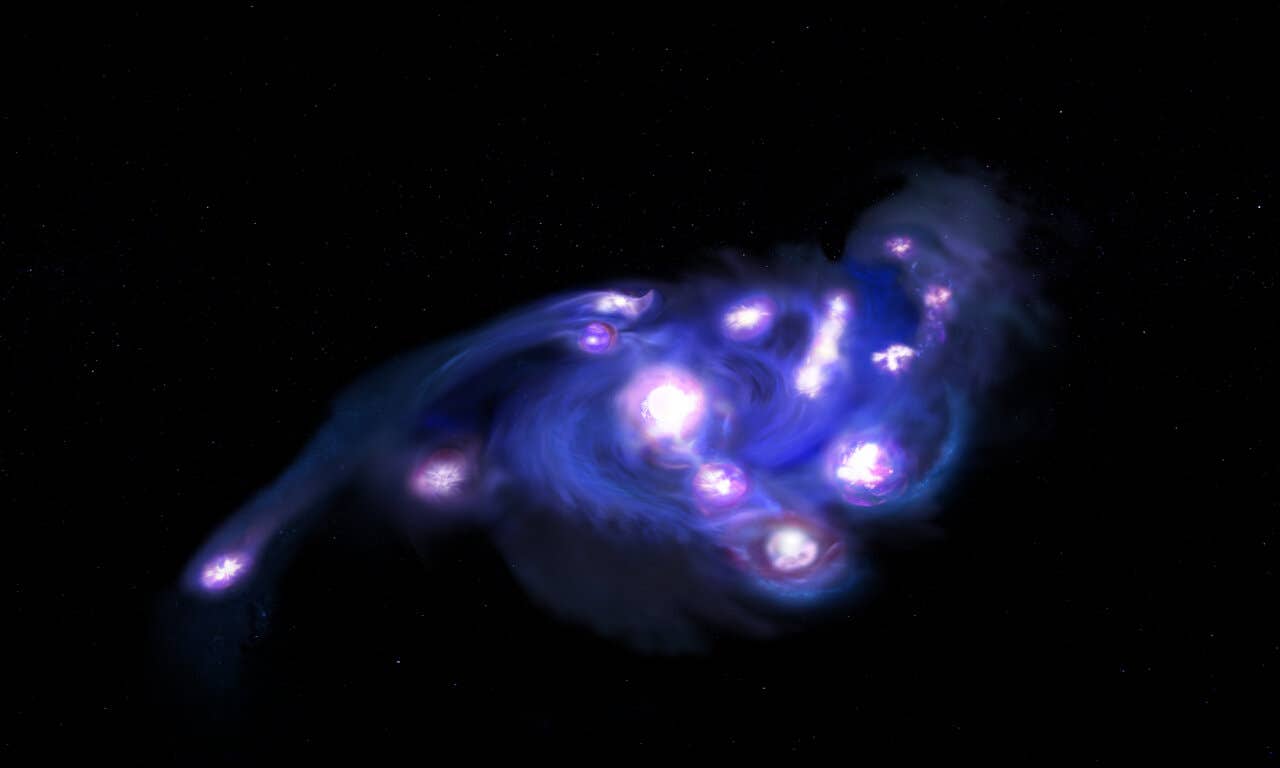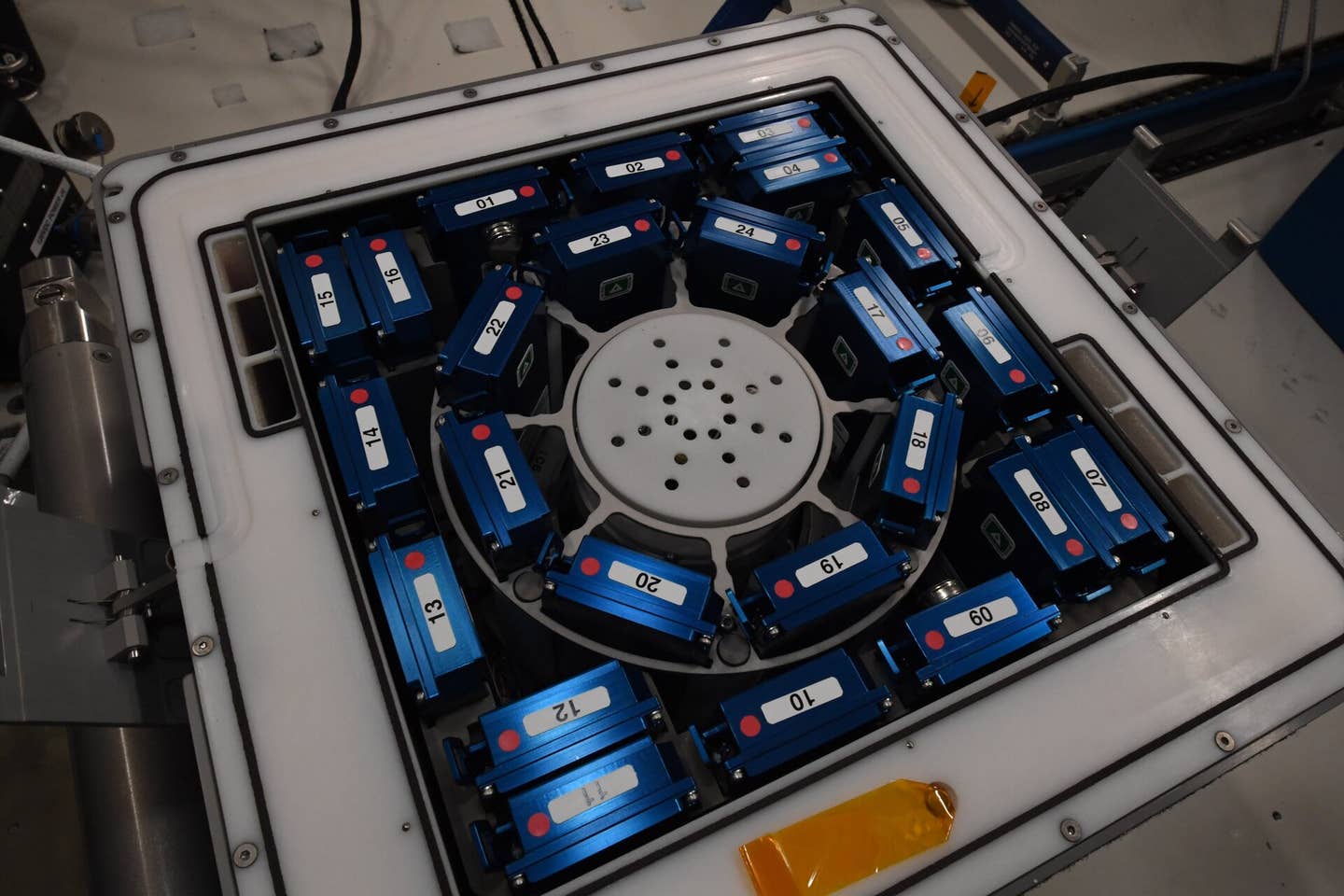Strange ‘Cosmic Grapes’ galaxy sheds new light on first billion years after Big Bang
Astronomers spot 15 star-forming clumps in the Cosmic Grapes galaxy, reshaping ideas of early galaxy growth.

A galaxy from the early universe, nicknamed Cosmic Grapes, is brimming with 15 massive star-forming clumps, giving astronomers a new look at how young galaxies evolve. (CREDIT: NSF/AUI/NSF NRAO/B. Saxton)
Astronomers have gotten a rare close-up look at a galaxy from the early universe and found it’s chock full of star forming activity in a way no one expected. Nicknamed “Cosmic Grapes,” this ancient system is 13 billion light years away and 930 million years after the Big Bang. What’s unique is the abundance of massive star forming clumps – at least 15 of them – all packed into its spinning disk, looking like a bunch of grapes suspended in space.
The discovery was made possible by a combination of fancy telescopes and a natural trick of the universe. A foreground galaxy, RXCJ0600-2007, acts as a natural magnifying glass through a phenomenon called gravitational lensing, bending and amplifying the light from the distant Cosmic Grapes.
“This is one of the most strongly gravitationally lensed distant galaxies ever discovered,” said lead author Seiji Fujimoto of the University of Toronto, who started the work while at the University of Texas at Austin’s McDonald Observatory. The natural magnification, plus the precision of NASA’s James Webb Space Telescope (JWST) and the Atacama Large Millimeter/submillimeter Array (ALMA), gave scientists a never before seen view of the galaxy’s inner workings.
Looking Inside Cosmic Grapes
Over 100 hours of observations, the team got the most detailed images yet of the galaxy’s innards. Earlier Hubble Space Telescope images showed it as a smooth spinning disk. But ALMA and JWST’s higher resolution showed a different story – intense, compact pockets of gas fueling rapid star formation. These dense clumps are so bright and massive they dominate the galaxy’s young light.
“Our observations show that some early galaxies’ young starlight is dominated by several massive, dense, compact clumps rather than one smooth distribution of stars,” said study co-author Mike Boylan-Kolchin, an astronomy professor at UT Austin. So what looked like featureless disks in the early universe may have been hiding complex internal structures all along.
Related Stories
- Distant galaxy’s black hole offers extraordinary glimpse into the Milky Way's future
- Most distant spiral galaxy ever found shatters theories of cosmic formation
Rethinking Galaxy Growth
Beyond its pretty face, Cosmic Grapes tells us about how the first galaxies formed. This is the first time scientists have been able to link a galaxy’s rotation to such well defined clumps, so these dense star forming knots can be important for galaxy growth. Instead of forming stars evenly across a disk, early stars may have formed in bursts and merged and smoothed out over time.
The results are in Nature Astronomy. They challenge long held assumptions about early galaxy formation and open up the possibility for more studies of similarly lensed galaxies to see if Cosmic Grapes is a one off or part of a bigger pattern in the early universe.
Previous Results
In recent years ALMA has shown that some galaxies from this epoch have a few bright knots of gas and dust but nothing like the dense “grape bunch” we see here. Other work using gravitational lensing has shown details in individual galaxies helping us understand star formation in the first billion years after the Big Bang.
Implications of the Research
This gives us a better understanding of how galaxies in the early universe built their stellar populations. Now we know that massive, tightly packed clumps dominate young galaxies so we can refine our galaxy evolution models and understand how the Milky Way formed.
On a larger scale Cosmic Grapes will guide future JWST and ALMA observations so we know where to look and what to look for in the early universe.
Note: The article above provided above by The Brighter Side of News.
Like these kind of feel good stories? Get The Brighter Side of News' newsletter.



